The best tour packages for climbing Kilimanjaro 2025-2026
Select the best tour package to climb Kilimanjaro up to the summit.
Mount Kilimanjaro Overview: Everything you need to know
Kilimanjaro towers at 5,895 m/19,341 ft above sea level. It is the highest free-standing mountain in the world and the "Roof of Africa". At Kiliserengoro Tours, we take immense pride in guiding adventurers to the summit of this legendary peak. Mt. Kilimanjaro is one of the most popular travel attractions on the continent — an incredibly beautiful trek where climbers don't require technical climbing skills. To reach the summit, one needs only a healthy average fitness level and a spirit for adventure. We at Kiliserengoro Tours have created this detailed guide to help travelers prepare for their once-in-a-lifetime Kilimanjaro adventure. Drawing on over 11 years of experience and more than 20,000 successful climbs, it covers everything you need to know: summit success rates, route comparisons, costs, training, acclimatization, insurance, arrival in Tanzania, safety, and more — all based on insights from our dedicated decade on the mountain. Climbing Mount Kilimanjaro is an adventure like no other. Towering at 5,895 meters (19,341 feet), it is the highest free-standing mountain on Earth, proudly called the “Roof of Africa.” Its majestic silhouette dominates the Tanzanian skyline and draws thousands of trekkers annually, each eager to conquer its iconic summit.
This guide is designed to prepare travelers for their once-in-a-lifetime Kilimanjaro journey. It provides comprehensive information on routes, climbing difficulty, success rates, costs, acclimatization, safety measures, and packing essentials. Drawing from years of guiding experience, Kiliserengoro Tours offers practical advice and insider tips to ensure every climber feels confident and ready for Africa’s ultimate trekking challenge.
Kilimanjaro features a diverse range of ecosystems along its slopes — from lush rainforest and heather zones to alpine deserts and the glaciated summit. Understanding these zones helps climbers prepare physically and mentally, plan acclimatization days, and appreciate the mountain’s unique biodiversity. This overview also highlights key factors influencing your climb, such as weather patterns, optimal climbing seasons, and expert tips to maximize your chances of reaching Uhuru Peak.
Kiliserengoro Tours emphasizes safety, sustainability, and unforgettable experiences. Whether it’s your first high-altitude trek or you are an experienced mountaineer, this guide helps plan every aspect of the adventure — from selecting the right route to understanding group logistics, emergency protocols, and proper gear. Every step on Kilimanjaro is a step into an awe-inspiring landscape, and preparation is key to ensuring you savor each moment.
How Hard Is It to Climb Mount Kilimanjaro?
Can a Beginner Climb Kilimanjaro?
Yes, Kilimanjaro is accessible to beginners with no trekking experience. The key factor isn’t hiking skills but proper acclimatization, which is best achieved on a 7–8-day route. To improve your chances of reaching the summit, choose a reliable outfitter like Kiliserengoro Tours and follow your guides’ safety instructions.
For insights on what to expect on your Kilimanjaro climb, read “What I Wish I Knew Before Climbing Kilimanjaro” — a reflection by one of Kiliserengoro Tours’ past climbers.
If you're wondering how to physically prepare, check out our detailed Kilimanjaro training guide, designed to help trekkers of all levels build confidence before the climb.
Based on our data from 7 to 8-day route adventures, the chance to reach the top of Kilimanjaro with Kiliserengoro Tours is among the highest in the industry.
At the core of our expeditions are expert WFR-certified guides, trained by our in-house safety professionals, with unlimited bottled oxygen at each expedition, comprehensive medical kits, modern trekking gear, and the use of routes with optimal acclimatization for a safe and successful summit.
Climbing Mount Kilimanjaro is a physically demanding adventure that tests both body and mind. Standing at 5,895 meters (19,341 feet), it is the highest free-standing mountain on Earth. While no technical climbing skills or ropes are needed, altitude, long trekking hours, and fluctuating weather make it challenging. Proper preparation, pacing, and acclimatization are essential for success.
Physical Demands
Kilimanjaro treks are non-technical but require stamina, endurance, and strength. Trekkers face steep inclines, uneven terrain, rocky paths, and long hours on foot. Summit day is the most demanding, often taking 10–14 hours in cold temperatures with limited oxygen. Muscular endurance and cardiovascular fitness help, but mental determination is equally important.
- Trekking involves 5–8 hours of walking per day on most routes, sometimes more on summit day.
- Physical fitness is beneficial but not mandatory — training for hiking, stairs, and cardio is recommended.
- Longer routes (7–9 days) improve success rates because they allow gradual acclimatization.
Altitude Challenges
The main difficulty is altitude above 3,000 meters. Kilimanjaro is not technical, but altitude sickness (Acute Mountain Sickness, AMS) can affect anyone. Symptoms include headache, nausea, dizziness, fatigue, and loss of appetite. Careful pacing, hydration, and following the "climb high, sleep low" principle reduce risks.
- Symptoms can appear suddenly; listen to your body and inform guides immediately.
- Medications like acetazolamide (Diamox) can aid acclimatization but require consultation with a healthcare professional.
- Longer routes like Lemosho, Machame, and Northern Circuit allow safer altitude adaptation.
Mental Preparation
Mental endurance often matters more than peak fitness. Trekking through long nights, early mornings, and cold summit conditions requires determination, focus, and patience. Staying positive, setting small milestones, and relying on support from guides and fellow trekkers greatly improves your chances of reaching the top.
- Visualization and mental rehearsal help prepare for the challenge.
- Break the climb into segments — base to forest, heath zone, alpine desert, summit attempt.
- Motivation and adaptability are key; unexpected weather or fatigue can test mental resilience.
Summit Day Challenges
The summit night is the most strenuous and memorable part of the climb. Climbers start around midnight to reach Uhuru Peak by sunrise. Thin air, freezing temperatures, and the long duration make it both physically and mentally intense.
- Expect 6–8 hours ascending and 3–6 hours descending.
- Proper layering, trekking poles, and headlamps improve comfort and safety.
- Summit success is heavily influenced by pacing, hydration, and determination.
Common Mistakes to Avoid
- Choosing very short routes — limited acclimatization increases risk of altitude sickness.
- Overexerting early — a slow and steady pace is more effective.
- Ignoring guide instructions — guides are trained to manage altitude risks and safety.
- Neglecting nutrition and hydration — energy snacks and water are vital.
Tips to Make the Climb Easier
- Select a longer route (7–9 days) to improve acclimatization.
- Train with cardio, stair climbing, and long hikes before the trip.
- Wear proper layers for warmth, moisture management, and sun protection.
- Listen to your body — rest when needed and don’t rush summit day.
- Stay positive and focus on the experience, not just the summit.
How Long Does It Take to Climb Kilimanjaro?
Climbing Mount Kilimanjaro is a once-in-a-lifetime adventure. The time required depends on your chosen route, your pace, and your body’s ability to acclimatize. Most treks take between 5 and 9 days. While shorter treks like Marangu allow you to reach the summit faster, longer routes significantly improve success rates and reduce the risk of altitude sickness. Planning extra days can buffer against adverse weather or allow for rest if needed.
Typical Route Durations & Average Summit Success Rates
| Route | Duration | Average Summit Success Rate | Highlights |
|---|---|---|---|
| Marangu | 5–6 days | ~50% | Classic “Coca-Cola” route, hut accommodation, relatively short, steep ascent on summit day |
| Machame | 6–7 days | ~75% | Scenic, forested trail, “Whiskey Route,” better acclimatization, diverse terrain |
| Lemosho | 7–8 days | ~85% | Remote, panoramic views, gradual ascent, ideal for photography, high summit success |
| Rongai | 6–7 days | ~70% | Less crowded, northern approach, drier climate, gradual ascent with scenic vistas |
| Northern Circuit | 8–9 days | ~90% | Longest route, full circumnavigation, excellent acclimatization, incredible views, solitude |
Why Longer Routes Are Recommended
Trekking Kilimanjaro is primarily a test of endurance and acclimatization rather than technical skill. Longer routes allow your body to gradually adapt to high altitude, minimizing the risk of acute mountain sickness (AMS). For example, the Northern Circuit and Lemosho routes provide additional mid-altitude camps, giving trekkers the time needed for their bodies to adjust safely. By contrast, shorter routes like Marangu place more physical stress on climbers due to steep summit day ascents.
Additional Practical Advice
- Acclimatization Days: Consider adding extra nights at mid-altitude camps (2,800–3,600m) if you have a slower acclimatization rate.
- Weather Planning: Wet season (March–May, November) can make trails muddy and summit day more challenging. Dry season (June–October, December–February) offers clearer skies and better conditions.
- Pacing & Rest: Summit day can take 10–14 hours. Proper pacing, early starts, and frequent short breaks are essential.
- Nutrition & Hydration: Carry high-energy snacks, water, and electrolyte supplements. Staying hydrated improves acclimatization and reduces fatigue.
- Fitness Preparation: Aerobic training (hiking, running, cycling) and leg strength exercises increase endurance. Mental preparation is equally crucial — summit day tests mental endurance as much as physical strength.
- Gear & Logistics: Ensure layered clothing, windproof jackets, trekking poles, gloves, hat, and quality boots. Pack extra batteries for cameras and headlamps for early-morning departures.
- Guides & Support: Experienced guides help monitor altitude symptoms, adjust pace, and provide emergency support. Kiliserengoro Tours ensures high guide-to-climber ratios and professional care.
- Summit Success Tips: Start slowly, use the “pole-pole” technique (slowly-slowly), and avoid overexertion above 4,500m.
CTA Buttons for Planning
When is the Best Season to Climb Mount Kilimanjaro?
Planning your climb during the right season is critical for safety, comfort, and summit success. Mount Kilimanjaro is accessible year-round, but the best time to climb Kilimanjaro is during dry periods when trails are safer, visibility is excellent, and trekking conditions are more comfortable. Kiliserengoro Tours helps climbers select the optimal window for 2025–2026 for a smooth and unforgettable experience.
Optimal Climbing Windows
- January – March: Considered one of the best seasons to climb Kilimanjaro. Trails are quieter, temperatures are cooler, and the risk of rain is minimal. Summit snow may appear, creating spectacular photo opportunities. Ideal for climbers seeking solitude and a less crowded trekking experience.
- June – October: Peak climbing season with consistently dry weather, clear skies, and excellent visibility. These months offer higher summit success rates due to favorable acclimatization conditions. Trails may be busier, but the scenic beauty of the mountain, from lush rainforests to alpine deserts, is unmatched. Perfect for photography, wildlife spotting near the base, and witnessing the mountain’s iconic landscapes.
Off-Season Climbing
- April – May (Long Rains) & November (Short Rains): The mountain experiences wetter conditions with muddy, slippery trails and less predictable weather. These months are suitable for climbers looking for fewer crowds and a more adventurous experience. Proper gear, waterproof clothing, and flexibility are essential during these months.
- December: Occasional rains can occur. Early booking is recommended due to holiday travel spikes. Trails can be moderately busy, but the weather is generally manageable for determined trekkers.
Factors to Consider When Choosing Your Kilimanjaro Climbing Season
- Summit Success Rate: Dry seasons generally yield higher success due to less slippery terrain and improved acclimatization conditions.
- Scenic Views & Photography: Clear skies during January–March and June–October offer the best panoramic views of Africa’s highest peak and surrounding landscapes.
- Trail Crowds: Off-peak months provide solitude and intimate trekking experiences, while peak months provide ideal weather but more climbers on the trails.
- Altitude Considerations: Dry and sunny weather helps reduce the risk of altitude-related issues by keeping trails visible and trekking conditions predictable.
- Travel Planning: Account for travel delays, potential rest days, or acclimatization days. Buffer time ensures flexibility if weather impacts summit attempts.
Expert Tips for Choosing the Best Time
- Book well in advance for peak months to secure your preferred route, lodge, or tented camp.
- Consider your personal preference for solitude vs. social trekking when choosing between peak and off-season.
- Monitor weather forecasts for summit days to increase chances of clear views and safe trekking.
- Combine your Kilimanjaro climb with other Tanzania experiences (safari or Zanzibar beach) during optimal seasons for a complete adventure.
- Ensure proper gear, layers, and hydration strategies are adapted to the season you choose.
CTA Buttons for Planning
How Much Does It Cost to Climb Mount Kilimanjaro?
Understanding the cost of climbing Mount Kilimanjaro is crucial when planning your adventure. Kilimanjaro trek prices vary widely depending on the route, duration, level of comfort, and the operator you choose. For a high-quality, safe, and successful climb in 2025–2026, trekkers should expect to pay between $2,000 and $4,000 per person for a 6–8 day expedition.
Average Kilimanjaro Climbing Costs (2025–2026)
A typical climb package includes guides, porters, meals, camping equipment, park fees, and airport transfers. Here’s a general breakdown of what’s included in different price ranges:
- Budget Operators ($1,500–$2,000): Basic service level with limited equipment and larger groups. Often compromises on safety, food quality, or guide experience. Not recommended for first-time climbers.
- Mid-Range Operators ($2,000–$3,000): Well-balanced value offering professional guides, reliable gear, quality meals, and standard accommodations before and after the trek.
- Premium Operators ($3,500–$5,500): Focused on comfort and safety, featuring smaller groups, expert guides, advanced oxygen systems, private tents, and luxury lodges pre/post climb.
Detailed Cost Breakdown
| Category | Estimated Cost (USD) | Details |
|---|---|---|
| Park Fees & Permits | $800 – $1,200 | Mandatory fees for conservation, camping, and rescue services, regulated by TANAPA (Tanzania National Parks Authority). |
| Guides, Porters & Cooks | $700 – $1,200 | Professional team ensuring safety, logistics, cooking, and carrying equipment. Ethical operators follow fair wage policies. |
| Food & Gear | $400 – $700 | Nutritious meals, clean water, camping gear, and safety equipment included in the expedition package. |
| Hotels & Transfers | $200 – $500 | Pre- and post-climb accommodation in Moshi/Arusha and airport or park transfers. |
| Tips (Recommended) | $250 – $400 | Gratuities for guides, porters, and cooks — typically pooled and distributed fairly among the team. |
Factors That Affect Kilimanjaro Climbing Costs
- Route & Duration: Longer routes (7–9 days) cost more but increase summit success rates due to better acclimatization.
- Group Size: Private climbs cost more than group tours, but provide flexibility and personalized service.
- Operator Quality: Established, licensed companies like Kiliserengoro Tours invest in experienced guides, high-quality gear, and ethical working conditions.
- Time of Year: Peak season (June–October) can slightly increase prices due to higher demand.
- Inclusions & Add-ons: Oxygen systems, private toilets, satellite communication, and upgraded meals affect overall pricing.
Is It Worth Paying More?
While it’s tempting to choose a cheaper operator, it’s important to remember that Kilimanjaro is a high-altitude climb. Cutting costs often means less safety equipment, unqualified guides, or poor food quality — all of which reduce your summit chances. Investing in a reputable, licensed operator ensures proper acclimatization support, professional guidance, and ethical porter treatment, ultimately increasing your chances of success.
Example Budget Comparison (Per Person)
| Category | Budget | Mid-Range | Luxury |
|---|---|---|---|
| Duration | 5–6 days | 6–8 days | 7–9 days |
| Group Size | 8–12 climbers | 5–8 climbers | Private/Small (2–6 climbers) |
| Support | Basic | Standard Safety Gear | Premium Oxygen System + Medical Kit |
| Approx. Price (USD) | $1,500–$2,000 | $2,500–$3,500 | $4,000–$5,500 |
What Should I Pack for a Kilimanjaro Climb?
Preparing the right Kilimanjaro packing list can make or break your summit success. Mount Kilimanjaro’s terrain shifts dramatically from hot lowlands to freezing alpine deserts, so smart layering and essential gear are key. For 2025–2026 trekkers, we’ve compiled the ultimate guide to help you pack efficiently, stay warm, and climb safely.
You don’t need to overpack — every extra kilogram matters on the mountain. Rent heavy items like sleeping bags or trekking poles locally in Moshi or Arusha to save space and costs. Most professional operators, including Kiliserengoro Tours, provide a detailed gear checklist before your departure.
Clothing & Layering System
Kilimanjaro’s climate changes across five ecological zones — from rainforest to arctic summit. Dressing in layers allows you to adapt to these shifts easily.
- Base Layers: Moisture-wicking thermal tops and bottoms (avoid cotton).
- Mid Layers: Fleece or soft-shell jacket for insulation.
- Outer Layers: Waterproof and windproof shell jacket and pants.
- Down Jacket: Insulated down parka for freezing summit nights.
- Trekking Pants: Lightweight, quick-drying materials preferred.
- Gloves, Hats & Buffs: Warm beanie, liner gloves, and neck gaiter for wind protection.
Footwear & Accessories
Your feet are your most valuable asset on the trail. Invest in comfortable, high-quality hiking boots and break them in well before your trip.
- Hiking Boots: Waterproof, ankle-supportive, and broken-in.
- Camp Shoes: Lightweight sneakers or sandals for evenings.
- Thermal Socks: Several pairs of moisture-wicking wool or synthetic socks.
- Gaiters: Protect against mud, dust, and small rocks on rough terrain.
- Trekking Poles: Adjustable and collapsible — helpful for steep ascents and descents.
Gear & Equipment
Reliable equipment ensures both comfort and safety. Choose lightweight yet durable items that withstand high altitude and varying conditions.
- Backpack: 30–40 liters with a hydration system or water bottle pockets.
- Sleeping Bag: Rated for sub-zero nights (−10°C/14°F or lower).
- Headlamp: Essential for summit night — bring extra batteries.
- Trekking Poles: Shock-absorbing poles reduce strain on knees.
- Dry Bags: Keep clothes and electronics dry in changing weather.
- Rain Cover: For daypack and duffel protection during rainy sections.
Personal & Health Essentials
Staying healthy and hygienic on the mountain helps maintain morale and safety. These essentials are lightweight but indispensable.
- Sunscreen: SPF 30+ or higher for intense UV exposure.
- Sunglasses: UV-protected with wraparound lenses for summit glare.
- Toiletries: Toothbrush, wet wipes, quick-dry towel, and small biodegradable soap.
- First Aid Kit: Painkillers, blister care, band-aids, Diamox (if prescribed).
- Water Purification: Tablets or filters for emergency use.
- Power Bank: Cold drains batteries fast — bring extra for cameras and phones.
Pro Packing Tips for Kilimanjaro (2025–2026)
- Pack light — porters can carry up to 15kg (check your operator’s policy).
- Roll clothes instead of folding to save space.
- Use packing cubes for easy organization and quick access.
- Label all bags with your name and trekking route.
- Rent locally to save on baggage fees — sleeping bags, poles, and down jackets are widely available.
- Don’t forget personal comfort items: snacks, journal, small flag for summit photo!
What Are the Best Routes to Climb Mount Kilimanjaro?
Mount Kilimanjaro offers multiple trekking routes, each with unique scenery, difficulty levels, and acclimatization profiles. Whether you’re a first-time trekker or an experienced hiker, choosing the right Kilimanjaro route can make all the difference in your summit success.
Below, we break down the six most popular Kilimanjaro routes — Lemosho, Machame, Marangu, Rongai, Umbwe, and Northern Circuit — with their durations, highlights, and detailed package options ranging from 5 to 9 days.
Lemosho Route (7–9 Days) — The Most Scenic Route on Kilimanjaro
The Lemosho Route is widely considered the most beautiful path on Mount Kilimanjaro. It begins on the lush western slopes and offers trekkers an authentic wilderness experience before joining the Machame Route near the Shira Plateau. The trail traverses diverse landscapes — from montane rainforests to alpine deserts — and offers spectacular panoramic views of the Shira Ridge and Mount Meru.
Why Choose Lemosho Route:
✔️ Highest summit success rate (90%+)
✔️ Fewer crowds — quieter trails and richer wilderness
✔️ Excellent acclimatization profile over 7–9 days
✔️ Perfect for photographers and nature enthusiasts
Difficulty Level: Moderate
Best Season: January–March & June–October
Starting Point: Londorossi Gate
Ending Point: Mweka Gate
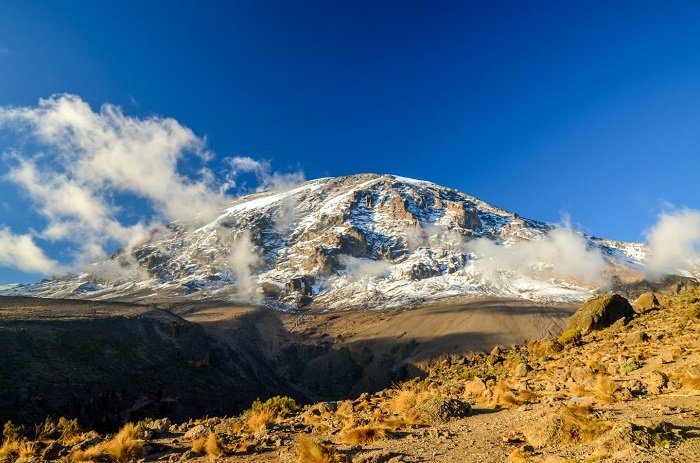
7 Days Lemosho Route
Designed for fit trekkers with limited time who want to experience Kilimanjaro’s western beauty. This route offers great scenery and moderate acclimatization.
- ✔️ Trek across the scenic Shira Plateau
- ✔️ Climb the Barranco Wall for panoramic views
- ✔️ Overnight at Barafu Camp before summit day
Duration: 7 Days / 6 Nights
Price: From $2,150 per person
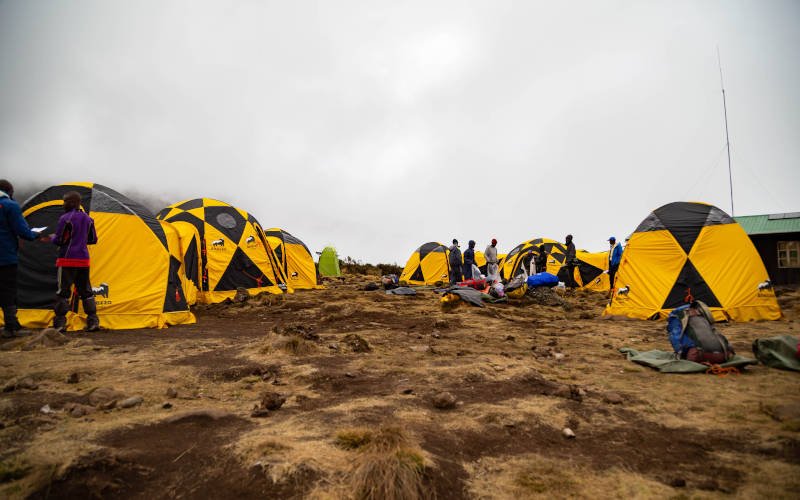
8 Days Lemosho Route
Our most recommended itinerary — it provides optimal acclimatization, comfortable pacing, and higher summit success. This version allows time for scenic photo stops and cultural encounters.
- ✔️ Excellent acclimatization profile
- ✔️ Extra rest day at Karanga or Shira Camp
- ✔️ Perfect balance of challenge and comfort
Duration: 8 Days / 7 Nights
Price: From $2,480 per person
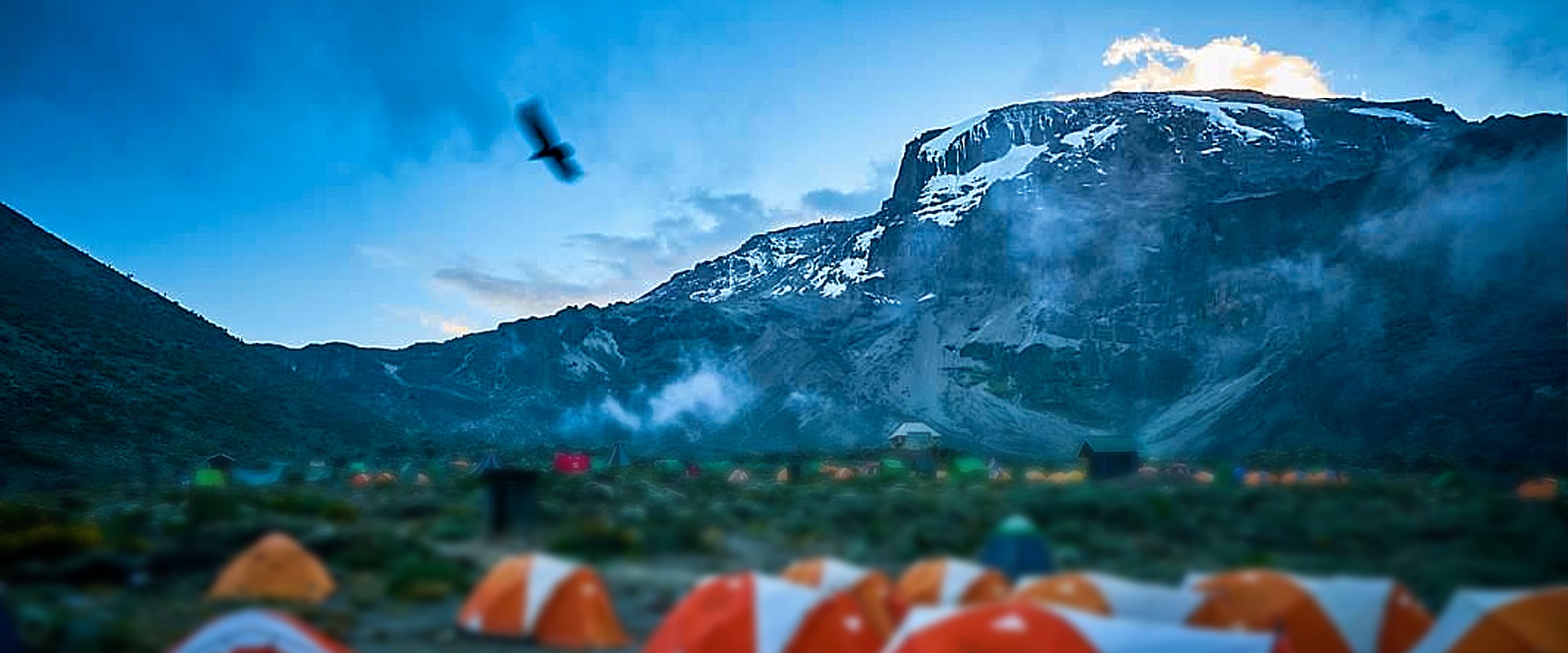
9 Days Lemosho Route
A premium, slow-paced version designed for maximum acclimatization and the ultimate photographic experience. Ideal for those who value comfort, relaxation, and the best chance of reaching Uhuru Peak.
- ✔️ Longest and safest version of Lemosho
- ✔️ Additional day for altitude adjustment
- ✔️ Luxury camp setup & hot meals daily
Duration: 9 Days / 8 Nights
Price: From $2,780 per person
Machame Route (6–8 Days) — The Classic “Whiskey Route” Experience
The Machame Route, famously known as the “Whiskey Route,” is one of the most popular and scenic trails to the summit of Mount Kilimanjaro. It starts at Machame Gate on the mountain’s southern base and winds through diverse ecosystems — from lush rainforest to heather and moorland, alpine desert, and finally the glacial summit of Uhuru Peak.
Trekkers enjoy varied landscapes, including the spectacular Barranco Wall, the beautiful Lava Tower, and the breathtaking views of Mount Meru. Machame provides an adventurous challenge with a rewarding sense of accomplishment.
Why Choose Machame Route:
✔️ Perfect balance between challenge and beauty
✔️ Excellent acclimatization profile with “climb high, sleep low” strategy
✔️ Highly successful route (75–85% summit rate)
✔️ Suitable for adventurous trekkers and nature lovers
Difficulty Level: Moderate to Challenging
Best Season: January–March & June–October
Starting Point: Machame Gate
Ending Point: Mweka Gate
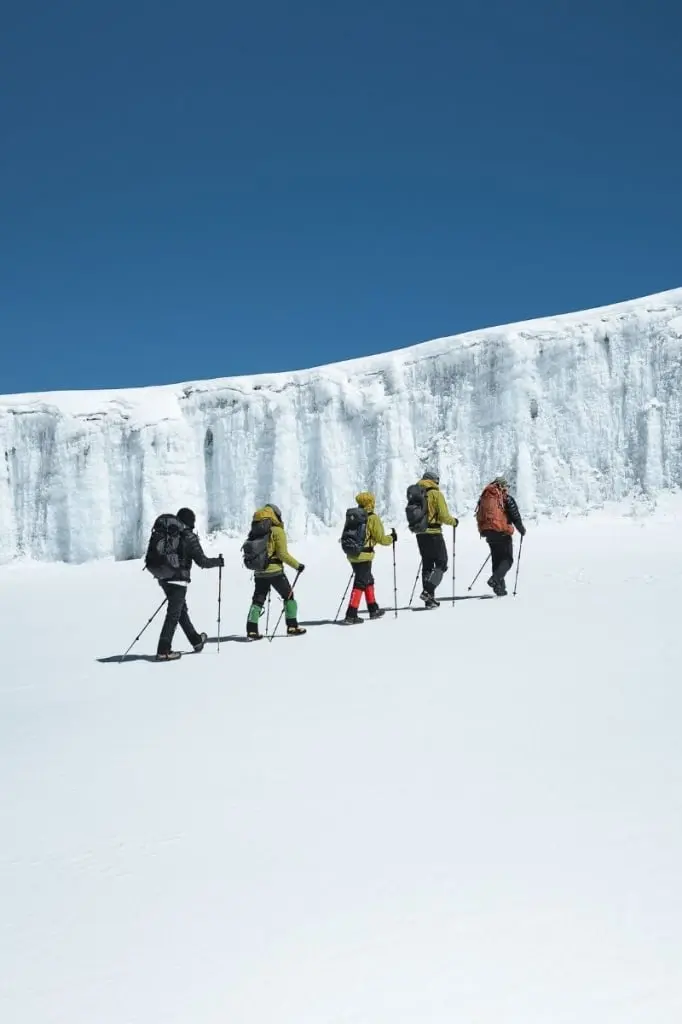
6 Days Machame Route
The shortest Machame itinerary — ideal for trekkers seeking a faster, more intense climb. Although physically demanding, it offers stunning scenery throughout.
- ✔️ Trek through rainforest to Shira Plateau
- ✔️ Pass the Lava Tower for acclimatization
- ✔️ Conquer the Barranco Wall before summit push
Duration: 6 Days / 5 Nights
Price: From $1,980 per person
.jpg)
7 Days Machame Route
Our most popular Machame itinerary — adds an extra acclimatization day at Karanga Camp, improving comfort and summit success. Ideal for moderately fit trekkers.
- ✔️ Excellent acclimatization profile
- ✔️ Full exploration of Barranco Valley
- ✔️ Higher summit success and reduced fatigue
Duration: 7 Days / 6 Nights
Price: From $2,250 per person

8 Days Machame Route
The most relaxed and rewarding Machame option — perfect for beginners and photographers who prefer a slower pace and additional rest day.
- ✔️ Additional acclimatization and scenic day
- ✔️ Great for first-time climbers
- ✔️ Enjoy sunrise and sunset views from Karanga Ridge
Duration: 8 Days / 7 Nights
Price: From $2,480 per person
Marangu Route (5–6 Days) — The Classic “Coca-Cola Route” Experience
The Marangu Route is one of the oldest and most established trails to Mount Kilimanjaro’s summit. Nicknamed the “Coca-Cola Route” due to the availability of refreshments along the way, it is the only route that provides hut accommodations rather than camping. Trekkers stay in shared mountain huts equipped with bunk beds, mattresses, and solar lighting — ideal for those who prefer comfort and simplicity.
Despite being considered less physically demanding, Marangu’s shorter itinerary makes altitude acclimatization more challenging. Many climbers underestimate it, but with an additional day for adaptation, it becomes an enjoyable and scenic trek.
Why Choose Marangu Route:
✔️ The only route with hut accommodation (Mandara, Horombo, Kibo Huts)
✔️ Well-defined paths and gradual incline
✔️ Great for first-timers who prefer structure and comfort
✔️ Spectacular views of Mawenzi Peak and the Saddle Plateau
Difficulty Level: Moderate
Best Season: January–March & June–October
Starting Point: Marangu Gate
Ending Point: Marangu Gate
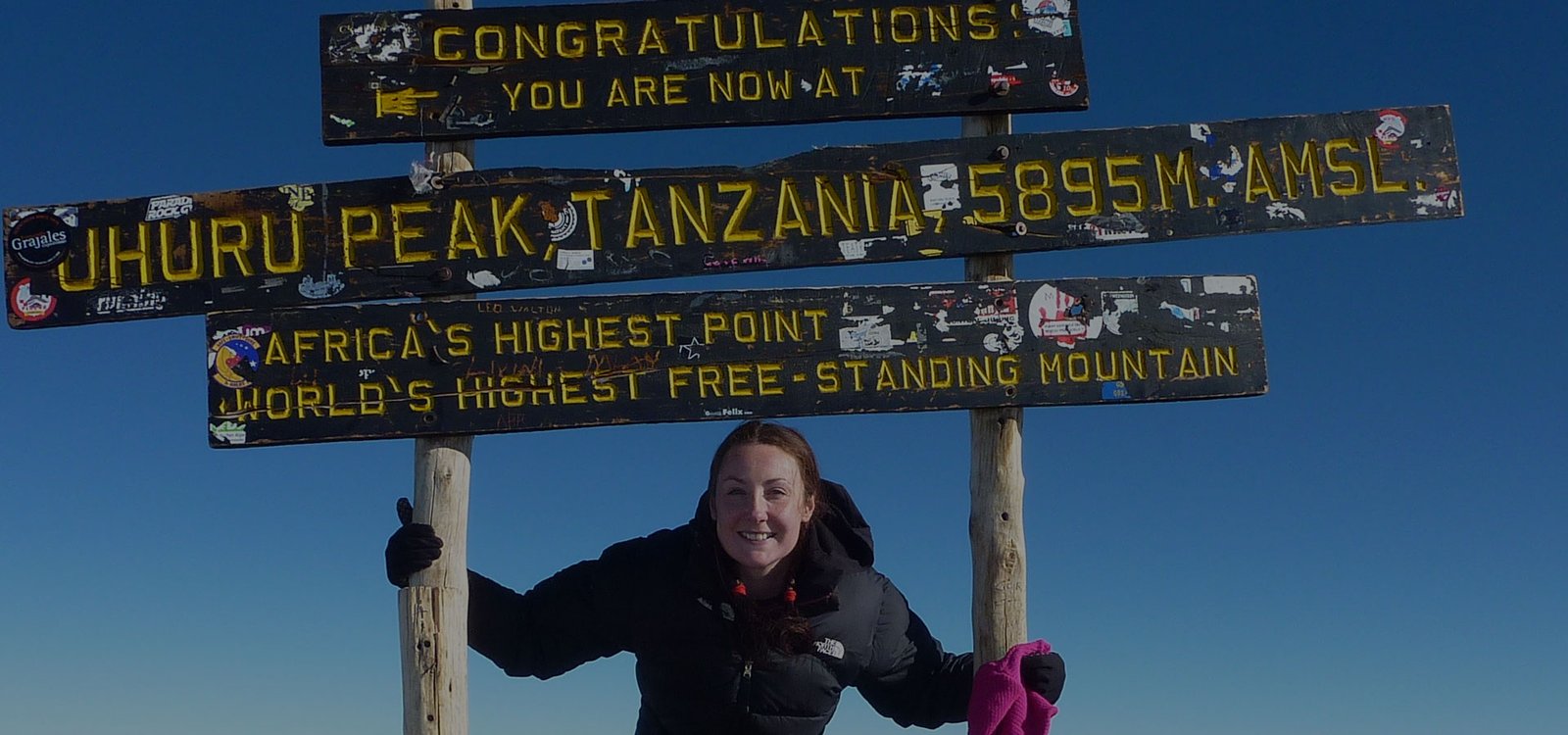
5 Days Marangu Route
Designed for experienced hikers or those with limited time, this itinerary covers the full Marangu trail in just five days. It’s fast-paced but still offers spectacular scenery through rainforest, moorland, and alpine desert.
- ✔️ Hut accommodation throughout the trek
- ✔️ Traverse rainforest, moorland, and summit glaciers
- ✔️ Ideal for repeat trekkers with high fitness levels
Duration: 5 Days / 4 Nights
Price: From $1,850 per person
.jpg)
6 Days Marangu Route
The most recommended Marangu option — includes an extra acclimatization day at Horombo Huts for better altitude adjustment and higher summit success. This itinerary is ideal for first-time climbers seeking comfort and safety.
- ✔️ Stay in Mandara, Horombo & Kibo Huts
- ✔️ Gentle trekking pace with guided support
- ✔️ Enjoy panoramic views of Mawenzi Peak
Duration: 6 Days / 5 Nights
Price: From $2,050 per person
Rongai Route (6–7 Days)
The Rongai Route offers a unique approach to Mount Kilimanjaro, beginning near the Kenyan border on the northern slopes. It’s known for its peaceful paths, low crowds, and incredible wilderness experience. Unlike the southern routes, Rongai remains drier year-round, making it a top choice for climbs during the wet seasons.
Why Choose Rongai Route: Ideal for trekkers seeking solitude, dry conditions, and gradual acclimatization. It provides panoramic views of the Amboseli Plains and a smooth ascent with fewer steep sections.
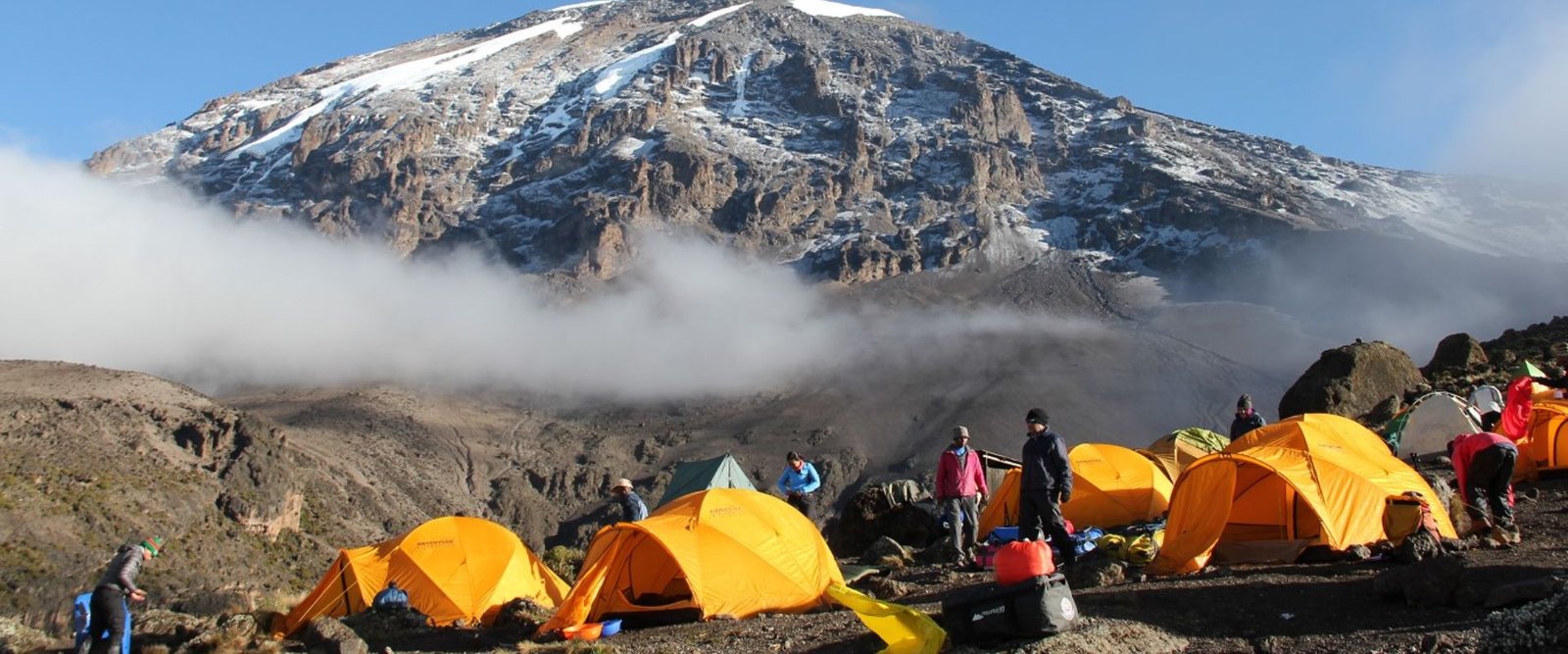
6 Days Rongai Route
This 6-day Rongai trek is designed for adventurers who want a quieter, off-beat experience on Kilimanjaro. The route ascends through pine forests, alpine moorland, and reaches Uhuru Peak via Gilman’s Point.
Highlights: Remote wilderness | Great views of Kenya | Low traffic | Fast-paced summit attempt.
Duration: 6 Days | Price: From $1,750 per person
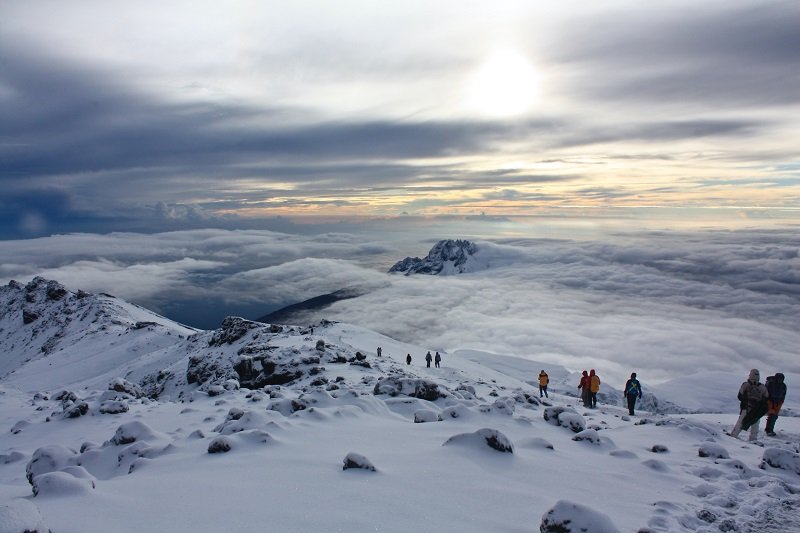
7 Days Rongai Route
The 7-day Rongai Route offers an additional acclimatization day at Mawenzi Tarn, giving climbers a better chance of reaching Uhuru Peak comfortably. This route is highly recommended for beginners or anyone looking for a more relaxed pace.
Highlights: Excellent acclimatization | Beautiful Mawenzi Tarn camp | Quiet northern wilderness | High summit success rate (~85%).
Duration: 7 Days | Price: From $2,150 per person
Umbwe Route (5–7 Days)
The Umbwe Route is the most adventurous and steepest trail up Mount Kilimanjaro, beginning from the southern base through dense rainforest and ascending sharply towards the Barranco Wall. Known for its raw wilderness and thrilling climbs, this route is best suited for seasoned mountaineers seeking a fast and direct ascent.
Why Choose Umbwe Route: Perfect for highly experienced and physically fit climbers who want a quiet, tough, and rewarding challenge to Africa’s highest peak. It’s less crowded, scenic, and intensely thrilling.
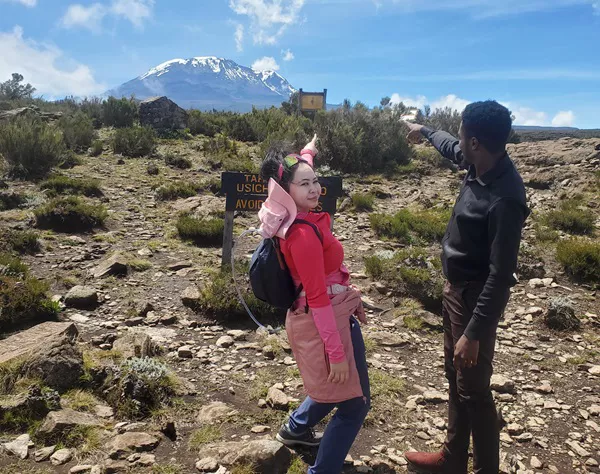
5 Days Umbwe Route
The 5-day Umbwe trek is a tough, direct climb for experienced and acclimatized trekkers. It’s a non-stop adventure through dense forest and rocky ridges, offering a thrilling, high-speed route to Uhuru Peak.
Highlights: Steep trails | Intense challenge | Fastest route to the summit | Minimal crowding.
Duration: 5 Days | Price: From $1,690 per person
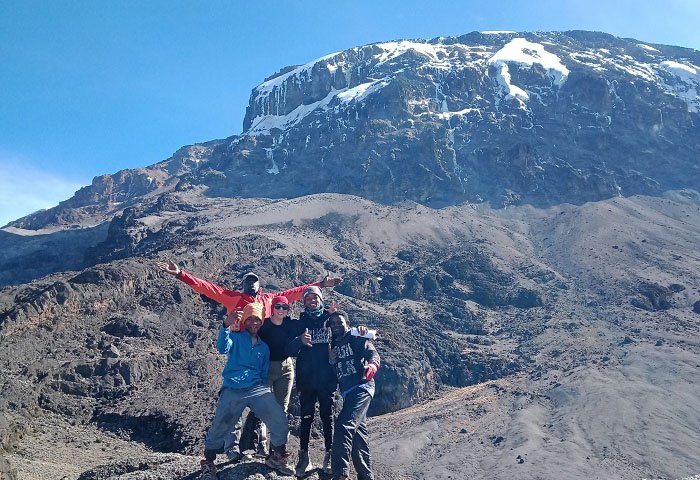
6 Days Umbwe Route
The 6-day Umbwe trek adds a crucial acclimatization day, making the climb safer and more enjoyable. Trekkers ascend from rainforest to alpine desert, experiencing spectacular views over the Shira Plateau and Western Breach.
Highlights: Balanced pace | Great acclimatization | Stunning wilderness camps | Serious adventure.
Duration: 6 Days | Price: From $1,950 per person
.jpg)
7 Days Umbwe Route
The 7-day Umbwe climb is the most recommended option — offering enough time for acclimatization, rest, and photography. It’s a rare and rewarding experience that combines intensity with magnificent scenery along the Machame trail before summit night.
Highlights: Best summit success | Extra acclimatization day | Fewer climbers | Most rewarding for pros.
Duration: 7 Days | Price: From $2,250 per person
Northern Circuit Route (8–9 Days)
The Northern Circuit Route is the **longest and most scenic path** on Mount Kilimanjaro. It circles the mountain in nearly 360°, offering unparalleled views of glaciers, alpine desert, and lush rainforests. Its gradual ascent ensures **excellent acclimatization**, making it the route with the **highest summit success rates** (around 90–95%).
Why Choose Northern Circuit: Ideal for trekkers with more time who value solitude, breathtaking landscapes, and a high probability of reaching the summit safely. This route also passes through remote areas where you’ll encounter fewer climbers.
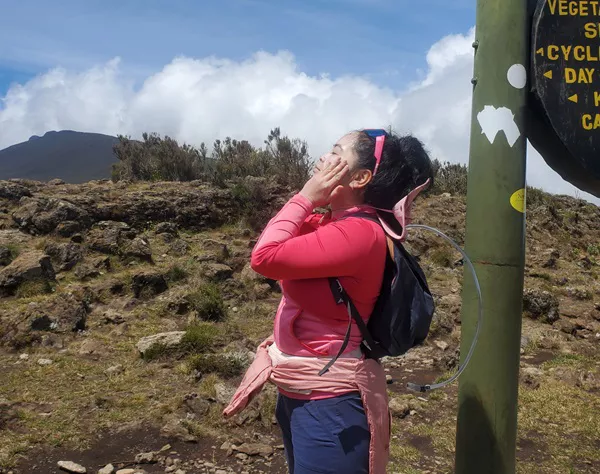
8 Days Northern Circuit
The 8-day Northern Circuit is a perfect combination of scenic variety, comfort, and steady acclimatization. Trek through lush forests, moorlands, and the Shira Plateau before ascending to the summit.
Highlights: Full mountain circle | Gradual ascent | Remote trails | Excellent summit odds.
Duration: 8 Days | Price: From $2,800 per person
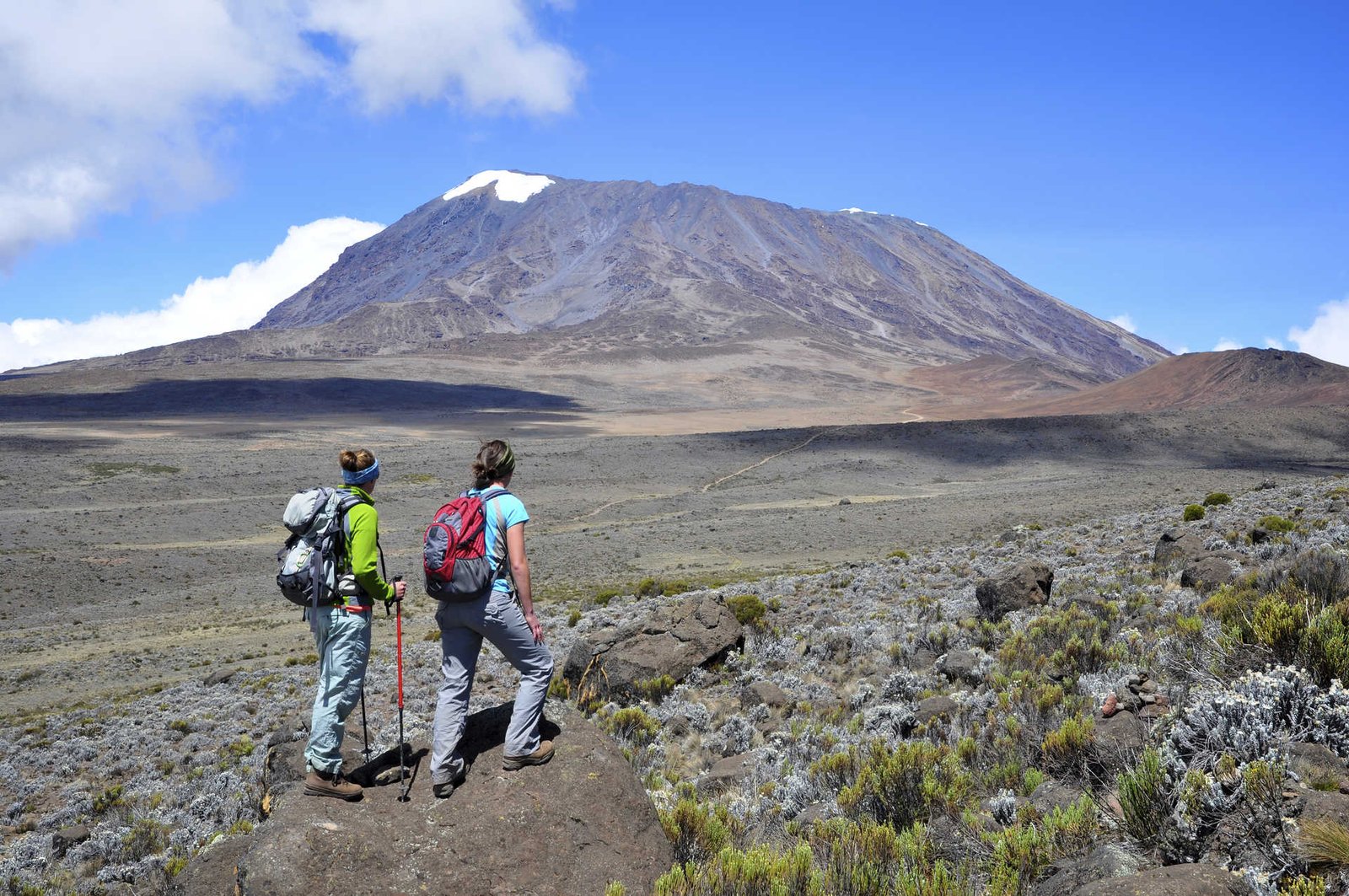
9 Days Northern Circuit
The 9-day trek is the **ultimate Northern Circuit experience**. It allows additional acclimatization, more time to explore remote sections, and a relaxed pace to enjoy the mountain fully. Perfect for photographers and adventure seekers.
Highlights: Maximum summit success | Luxury pace | Full scenic circuit | Quiet trails.
Duration: 9 Days | Price: From $3,200 per person
Kilimanjaro Route Comparison — Duration, Difficulty & Summit Success
Compare the most popular Kilimanjaro climbing routes for 2025–2026. See which route fits your time, fitness level, and adventure style. Detailed info on duration, difficulty, scenery, summit success, crowd level, and ideal season helps you make an informed choice.
| Route | Duration | Difficulty | Scenery & Highlights | Summit Success Rate | Crowd Level | Best Season |
|---|---|---|---|---|---|---|
| Lemosho | 7–9 Days | Moderate | Lush rainforest, Shira Plateau, Western Crater, Machame merge | 90%+ | Medium — quieter than Machame, but scenic | Jan–Mar, Jun–Oct |
| Machame | 6–8 Days | Moderate–Hard | Forests, Lava Tower, Barranco Wall, alpine desert | 80–85% | High — very popular and scenic route | Jan–Mar, Jun–Oct |
| Marangu | 5–6 Days | Easy–Moderate | Forested lower slopes, hut accommodation, steady trail | 60–70% | Medium–High — only hut-based route | Jan–Mar, Jun–Oct |
| Rongai | 6–7 Days | Moderate | Northern approach, dry terrain, Kenyan plains views, quiet trail | 70–80% | Low — remote and less crowded | Jan–Mar, Jun–Oct (best in rainy season) |
| Umbwe | 5–7 Days | Hard | Steep ascent, dense rainforest, rugged terrain | 55–65% | Very Low — steep and challenging, few climbers | Jan–Mar, Jun–Oct |
| Northern Circuit | 8–9 Days | Moderate | Full 360° views, remote areas, Shira Plateau, Lemosho merge | 90–95% | Low — longest and least crowded route | Jan–Mar, Jun–Oct |
Ready to plan your Kilimanjaro trek? Contact us on WhatsApp or send an email to get detailed quotes, available routes, and personalized packages for 2025–2026.
How Do You Acclimatize Safely on Kilimanjaro?
Proper acclimatization is the key to a successful and safe Kilimanjaro summit. Altitude sickness is the main challenge above 3,000 meters, and careful planning, pacing, and hydration are critical. Following these evidence-based strategies significantly improves your chances of reaching the “Roof of Africa” safely.
1. Choose Longer Routes
Routes lasting 7–9 days, such as Lemosho, Northern Circuit, or Machame, allow gradual altitude gain, giving your body enough time to adjust. Longer itineraries greatly improve summit success rates.
2. Climb Slowly (“Pole Pole”)
“Pole pole” means slowly in Swahili. Maintain a slow, steady pace on all ascents. Avoid rushing — your body adapts better when you gain altitude gradually.
3. Follow “Climb High, Sleep Low”
Ascend to a higher altitude during the day, then descend to sleep at a lower altitude. This technique improves oxygen acclimatization and reduces symptoms of altitude sickness.
4. Stay Hydrated
Drink 3–4 liters of water daily. Dehydration worsens altitude sickness. Include electrolytes or oral rehydration salts if possible, especially on high-altitude days.
5. Take Acclimatization Hikes
Short treks to higher points during the day before descending for the night help your body adjust to thinner air. Your guide will plan these strategically during the itinerary.
6. Avoid Alcohol and Smoking
Alcohol and smoking impair oxygen uptake and can worsen altitude-related symptoms. Stick to water, herbal teas, and light snacks.
7. Monitor Symptoms & Communicate
Common early signs of altitude sickness include headaches, nausea, dizziness, and fatigue. Report any symptoms immediately to your guide — they can adjust pacing, provide oxygen, or recommend descending if necessary. Safety always comes first.
8. Nutrition & Rest
Eat light, high-carbohydrate meals to maintain energy. Sleep well each night, but understand that sleep quality may decrease at higher altitudes. Short naps during the day are helpful.
9. Use Guides & Support
Experienced guides monitor your condition, regulate pace, and provide advice throughout the trek. Kiliserengoro Tours ensures each group has a trained guide and porter support to maximize safety and comfort.
Pro Tip: Gradual acclimatization combined with hydration, proper nutrition, and slow trekking is more important than peak fitness. Many climbers with average fitness reach the summit safely by following these principles.
Is Climbing Mount Kilimanjaro Safe?
Climbing Mount Kilimanjaro is generally safe when undertaken with certified guides and reputable operators. The main risks stem from altitude sickness, dehydration, weather exposure, or poor preparation. With proper planning, experienced support, and quality equipment, most trekkers complete the climb safely.
1. Certified Guides & Experienced Operators
Choosing a Kilimanjaro operator certified by KPAP (Kilimanjaro Porters Assistance Project) ensures safety standards, fair treatment of porters, and adherence to established trekking protocols. Guides are trained in first aid, altitude response, and emergency procedures, providing peace of mind throughout the climb.
2. Altitude Awareness & Health Monitoring
Altitude sickness is the most common risk above 3,000 meters. Guides continuously monitor climbers for early signs such as headaches, nausea, dizziness, and fatigue. Following acclimatization rules and reporting symptoms immediately reduces serious complications.
3. Emergency Oxygen & Medical Support
All guided treks carry emergency oxygen, first-aid kits, and communication devices. In case of severe altitude sickness or injury, trained staff can stabilize climbers and coordinate evacuation with park rangers if needed.
4. Reliable Rescue Services
Mount Kilimanjaro National Park maintains coordinated rescue services. Rangers and operators are trained to respond to emergencies, ensuring rapid assistance and evacuation when required.
5. Proper Gear & Preparation
Safe climbs require suitable clothing, hiking boots, layered insulation, and hydration systems. Properly packed gear reduces risks from cold, wind, and wet conditions while ensuring comfort during long summit days.
6. Safety Tips for Trekkers
- Always follow your guide’s instructions.
- Ascend slowly and take acclimatization days seriously.
- Stay well-hydrated and maintain high-energy intake.
- Inform guides immediately if feeling unwell.
- Ensure your operator respects KPAP standards and ethical practices.
Pro Tip: Even experienced trekkers should never underestimate altitude. Mental readiness, patience, and listening to your body are as important as physical fitness for a safe and enjoyable climb.
What Is Life Like on Mount Kilimanjaro?
Life on Kilimanjaro is structured around a steady daily routine designed to maximize safety, energy, and acclimatization. Trekkers follow a predictable pattern of waking, trekking, eating, and resting — with dedicated staff supporting every aspect of the climb.
1. Daily Routine
Most climbers wake between 6–7 AM, beginning the day with a cup of hot tea or coffee. Breakfast follows, often consisting of porridge, eggs, and fruits for a high-energy start. Daily treks last 5–7 hours with intermittent breaks, allowing gradual ascent and acclimatization.
- Wake-up: Early tea, hydration, and warm clothing.
- Breakfast: Energy-rich meals such as porridge, eggs, toast, or pancakes.
- Trekking: Slow, steady ascent with regular rest stops (“pole pole” approach).
- Lunch: Light, nutritious meals at scenic rest points.
- Afternoon: Camp arrival, rest, optional short acclimatization walks.
- Dinner: Hot, hearty meals with soups, pasta, rice, vegetables, and protein.
- Evening: Relax, journal, or enjoy stargazing before early sleep.
2. Accommodation & Campsites
Accommodation varies by route:
- Tented Camps: Most routes provide tented camps with basic but comfortable facilities. Tents are equipped with sleeping mats and mattresses.
- Eco-friendly Toilets: Composting or portable toilets are provided at campsites.
- Huts: Marangu route offers permanent huts with beds — easier on climbers who prefer indoor shelter.
- Group Size: Typically 3–4 staff per climber, including guides, porters, and cooks for safety, comfort, and support.
3. Meals & Nutrition
Mountain cooks ensure energy-rich meals that sustain climbers through long days. Meal planning includes:
- Soups and stews for warmth and hydration.
- Carbohydrate-rich options such as rice, pasta, and potatoes for energy.
- Protein sources including beans, eggs, and occasionally meat or fish.
- Fresh fruit and vegetables when available to maintain vitamin intake.
4. Social & Team Environment
Life on Kilimanjaro is also about camaraderie:
- Guides and porters provide motivation, local knowledge, and assistance with trekking techniques.
- Trekkers often form strong bonds with their climbing team, sharing stories and experiences along the way.
- Evenings around camp encourage relaxation, storytelling, and stargazing under clear mountain skies.
How Much Should You Tip on Kilimanjaro?
Tipping is an important part of the Kilimanjaro climbing culture. Porters, guides, and cooks work hard to ensure your climb is safe, enjoyable, and well-supported. While not legally mandatory, tipping is customary and strongly encouraged as a token of appreciation for their dedication.
Recommended Tipping Guidelines
The total recommended amount usually ranges between $250–$400 per climber, depending on the length of the trek, group size, and quality of service. Here’s a suggested breakdown:
- Lead Guide: $20–25 per day — responsible for route safety, acclimatization advice, and overall trip management.
- Assistant Guide: $15–20 per day — supports the lead guide, assists climbers, and monitors group well-being.
- Cook: $10–15 per day — prepares high-quality meals at altitude and manages kitchen logistics.
- Porter: $5–10 per day — carries equipment and supplies, ensuring climbers’ comfort and minimizing fatigue.
Tips Distribution & Best Practices
- Tips are generally collected in a group ceremony at the end of the climb and distributed evenly among the staff according to the lead guide’s recommendations.
- Bring cash in USD (small denominations: $1, $5, $10) for easy handling.
- Be mindful of the number of staff supporting your climb — larger groups may require slightly higher total tips.
- Show appreciation for exceptional service — it is customary to thank staff personally along with monetary tips.
Additional Notes
- Some operators include suggested tipping amounts in the pre-climb briefing or final invoice.
- While tipping is customary, it remains voluntary. Exceptional service can be rewarded generously.
- For longer treks, consider proportionally adjusting the tips per day to reflect additional effort and time spent by staff.
Why Choose KILISERENGORO Tours for Climbing Mount Kilimanjaro?
Choosing Kilidove Tours ensures you climb Africa’s highest peak with safety, professionalism, and unforgettable adventure. Our team prioritizes climber success, ethical practices, and personalized support at every step.
Certified and Experienced Guides
- All guides are trained Wilderness First Responders and licensed Kilimanjaro guides.
- Over 1,000 successful summits guided with exceptional 5-star reviews.
- Expert knowledge of routes, acclimatization strategies, and altitude response ensures high safety standards.
High Summit Success Rates
- Over 90% success rate on 7–9 day routes.
- Longer routes and gradual pacing increase chances of reaching the summit safely.
- Acclimatization strategies and “pole pole” (slowly) approach reduce altitude-related risks.
Ethical & Responsible Tourism
- KPAP-certified, ensuring fair treatment of porters, adequate rest, and proper equipment.
- Eco-friendly practices: minimal environmental impact, waste management, and sustainable trekking policies.
- Community engagement: supporting local villages and employing local staff whenever possible.
Transparent Pricing & Custom Support
- Clear, upfront pricing covering guides, porters, meals, accommodation, and park fees.
- Flexible itineraries tailored to fitness level, schedule, and special requirements.
- 24/7 support pre-climb and during the trek for personalized assistance.
Frequently Asked Questions About Climbing Kilimanjaro
Everything you need to know to prepare for a safe, enjoyable, and successful Kilimanjaro trek in 2025–2026. Each answer is designed with practical guidance from experienced Kiliserengoro Tours guides.
- What physical fitness level do I need to climb Kilimanjaro?
- Kilimanjaro is a non-technical climb but physically demanding. You should have good cardiovascular fitness, stamina, and the ability to hike 5–7 hours per day with a backpack. Regular hiking, cardio exercises, and strength training for legs and core improve performance.
- How do I maximize my chances of reaching the summit?
- Choose a longer route (7–9 days), climb slowly (“pole pole”), stay hydrated, follow your guide’s pacing, and get adequate rest. Summit success also depends on weather, altitude acclimatization, and avoiding overexertion.
- Can beginners climb Kilimanjaro or do I need experience?
- Yes, beginners can climb with proper preparation, a guided group, and selecting an acclimatization-friendly route. Previous trekking experience helps but is not mandatory.
- What is the age limit for climbing Kilimanjaro?
- Kilimanjaro is typically open to climbers aged 10 and above. Minors should be accompanied by adults. Senior climbers must consult their doctor, especially if they have pre-existing health conditions.
- What altitude sickness symptoms should I watch out for on Kilimanjaro?
- Symptoms include headaches, nausea, dizziness, shortness of breath, fatigue, and difficulty sleeping. Always report symptoms to your guide and follow recommended acclimatization and hydration practices.
- Are there guides and porters available on Kilimanjaro treks?
- Yes. Certified guides, assistant guides, porters, and cooks accompany all climbs. Kiliserengoro Tours ensures KPAP-certified operators for fair treatment, proper rest, and safe working conditions.
- What kind of weather should I expect on Kilimanjaro?
- Weather varies by altitude and season. Expect warm, humid conditions in the rainforest, cold winds in alpine desert, and sub-zero temperatures near the summit. Rain can occur in April-May (long rains) and November (short rains).
- Is technical climbing gear required for Kilimanjaro?
- No technical climbing gear (ropes, harnesses) is needed. Essentials include hiking boots, trekking poles, warm layers, headlamp, gloves, and waterproof outerwear.
- What accommodation or camping arrangements are there on the mountain?
- Options depend on the route: tented camps for most routes or huts on the Marangu Route. Camps provide basic amenities, meals are prepared by experienced mountain cooks, and eco-friendly toilets are available at each campsite.
- How many calories or food should I bring during the trek?
- All meals are included by your operator, typically 3–4 energy-rich meals per day (soups, carbs, protein). Additional snacks like energy bars are recommended for summit day.
- How do I prepare physically and mentally for Kilimanjaro?
- Train for endurance and strength: long hikes, stair climbing, cardio, and core exercises. Mentally, plan for early wake-ups, altitude challenges, and variable weather. Visualization and positive mindset improve success.
- Are there any health risks or vaccinations needed before climbing?
- Consult a travel clinic. Common recommendations include Yellow Fever (depending on origin), Tetanus, Hepatitis A/B, and routine vaccinations. Altitude sickness and dehydration are main risks; bring personal medications and a basic first aid kit.
- What safety measures are in place for Kilimanjaro climbers?
- Certified guides, emergency oxygen, first aid kits, and rescue plans are standard. KPAP-certified operators follow strict safety protocols. Always follow guides’ instructions and stay with your group.
- How to acclimatize properly while climbing Kilimanjaro?
- Ascend slowly, drink 3–4 liters of water daily, climb high and sleep low when possible, take acclimatization hikes, and rest immediately if feeling unwell. Longer treks improve acclimatization and reduce altitude sickness risk.
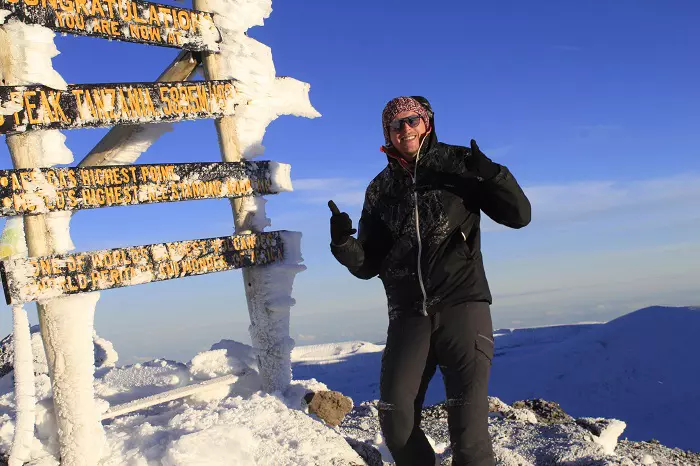
Lemosho route climbing tour packages 2025
Lemosho route KilimanjaroPackages: 6, 7, 8 & 9-days
Lemosho route Kilimanjaro climbing tour offers 6, 7, 8, and 9-day packages. The route has the best stunning view of the Kilimanjaro since the day 1 of climbing. Also, Lemosho it has the high success rates and now is the popular route. It is one among of the routes that starts from the west of the mountain.
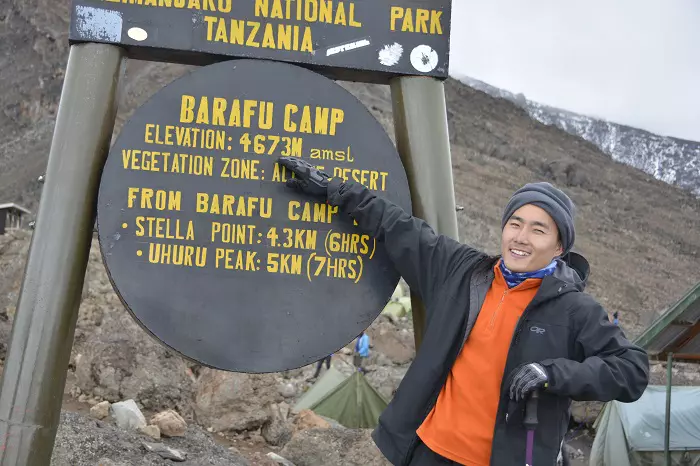
Machame route climbing tour packages 2025
Machame route KilimanjaroPackages: 6-day & 7-day
Machame route Kilimanjaro climbing tour offers 6-day and 7-day packages. This route is also known as "Whiskey Route" due to some challenges during climbing Kilimanjaro. The route starts from the south of the mountain which also offers the scenic view of the mountain. The success rates not high as compared to Lemosho.

Marangu route climbing tour packages 2025
Marangu route KilimanjaroPackages: 5-day & 6-day
Marangu route Kilimanjaro climbing tour offers 5-day and 6-day packages. This route is also known as "Coca-Cola Route" because is the easiest route and offers its accommodations in huts and not in tents like other routes. The Marangu route starts from the East of Kilimanjaro and it has high success rates to reach the summit.
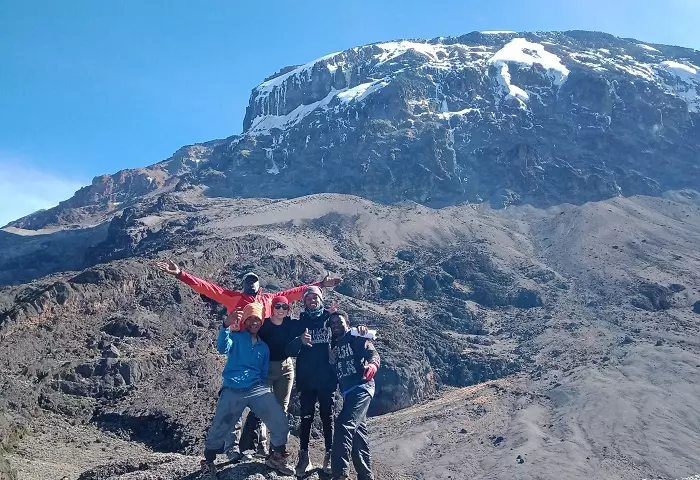
Rongai route climbing tour packages 2025
Rongai route KilimanjaroPackages: 6-day & 7-day
Rongai route Kilimanjaro climbing tour offers 6-day and 7-day packages. The Rongai route is the easiest route in climbing Kilimanjaro because it has gentle slopes. It is the only route that starts from the north near the Kenyan border. It has high success rates to reach the summit and also is has no crowds but few scenic views.
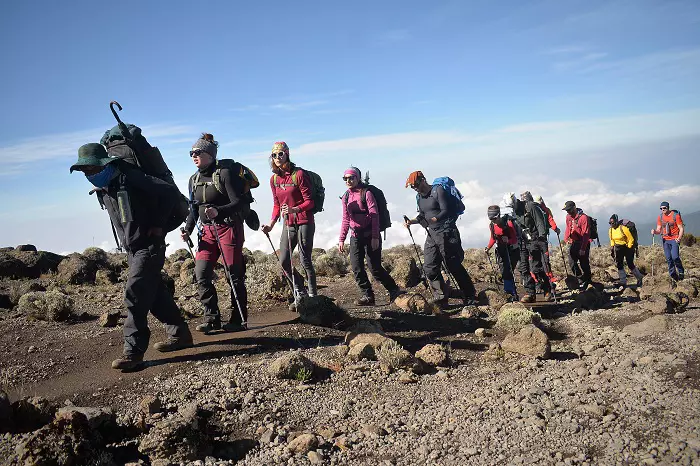
Umbwe route climbing tour packages 2025
Umbwe route KilimanjaroPackages: 6-day & 7-day
Umbwe route Kilimanjaro climbing tour offers 6-day and 7-day packages. The Umbwe route is the heardest and most challenging route during climbing Kilimanjaro. This Umbwe route goes straight up to the peak of Kilimanjaro and needs competitive trekkers due to low success rates as compared to all routes. Also, this route starts from the south of the mountain.

Northern Circuit route climbing tour packages 2025
Northern Circuit route KilimanjaroPackages: 11-days
Northern Circuit route Kilimanjaro climbing tour offers 11-days package. The Northern Curcuit is the longest route used to climb Kilimanjaro starting in the west side. It has high success rates to reach the summit due to much time to acclimatize on high altitudes so as to provide adaptability to the climber on mountaneous climates
